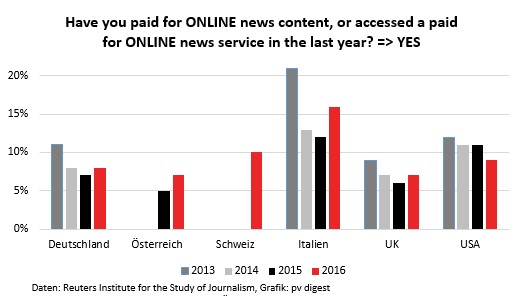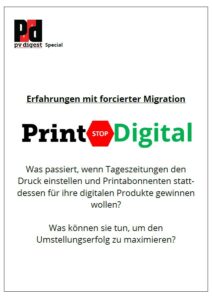Some annotations to Reuters ‘ Pay Models in European News’
(19.5.2017)
The Reuters Institute for The Study of Journalism recently published a “factsheet” called ‘Pay Models in European News’. Many of those facts were cited and republished from a variety of media websites without any further reflection. Here, one should take into consideration the fact that this institute over the last years published a series of reports showing a decrease in the number of people paying for news – a completely implausible and contra-intuitive insight concerning the yearlong growth of websites with a paywall and quite a lot of studies demonstrating the opposite (arguably there are much too few people willing to pay for news. But their number, how small it might be, for sure is growing since years. Only last years ‘Digital News Report’ showed what is to be expected: a growth in the number of people paying for news.)
One should also note some key facts concerning yesterdays “factsheet” and ask some questions:
- The data is based upon a sample which by no means is representative (which isn’t claimed by the papers authors). So any given average or percentage doesn’t mean anything with respect to reality as whole.
- The ‘study’ includes for each country the 15 national and regional newspapers with the highest print circulation. That might be an explainer for the very high average monthly prices the study finds.
- But then, the study also includes “up to four additional news organisations in each country … that we knew in advance are important parts of the overall media landscape and represent important examples of digital journalism”. That might be an explanation for anything and will surely distort the results, though it is impossible to guess in which direction.
- E.g. the study finds that nearly half of Germany’s newspapers has a paywall installed. But Germany’s newspaper publishers association BDZV just finished a complete list of all paywalled websites in Germany related to a newspaper. That list is based on the cumbersome process of clicking through near to 700 websites to make sure that even a hidden metered paywall would be found. It is not easy to say how exactly the 215 sites in this list relate to the number of newspapers in Germany since many papers are running more than just one website. But it is sure to say, that it is rather around a third of German newspapers (cf the below piece from pv digest #5/2017), not nearly half of them.
- Then, the study includes “The 5 digital born news websites (domestic and/or international) in a broad sense with the highest reach in each of the countries”. It is hard to think of a more effective way of excluding paywalled-websites than to base their selection upon reach. So what does the study’s finding that “almost all (97%) the digital-born news media offer free access to their news” mean with respect to any meaningful reality outside the study’s sample?
One should think it to be a blessing for the struggling European media world, that there is an institution like the Reuters Institute which is well funded and which is investing a lot of money into researching the paid content question. But it must be noticed that the Reuters Institute for The Study of Journalism is hard working to be regarded as infamous for publishing reports and studies with a very questionable validity of their findings.

